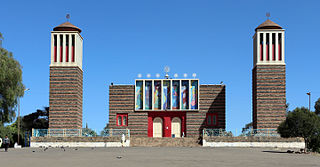
The Ethiopian Orthodox Tewahedo Church is the largest of the Oriental Orthodox Churches. One of the few Christian churches in sub-Saharan Africa originating before European colonization of the continent, the Ethiopian Orthodox Tewahedo Church dates back to the Christianization of the Kingdom of Aksum in 330, and has between 36 million and 51 million adherents in Ethiopia. It is a founding member of the World Council of Churches. The Ethiopian Orthodox Tewahedo Church is in communion with the other Oriental Orthodox churches.

Frumentius was a Phoenician Christian missionary and the first bishop of Axum who brought Christianity to the Kingdom of Aksum. He is sometimes known by other names, such as Abuna and Aba Salama.

The Church of Our Lady, Mary of Zion is an Ethiopian Orthodox Tewahedo Church which is claimed to contain the Ark of the Covenant.

Abune Paulos was the fifth Patriarch of the Ethiopian Orthodox Tewahedo Church from 1992 to his death in 2012. His full title was "His Holiness Abuna Paulos, Fifth Patriarch of the Orthodox Tewahido Church of Ethiopia, Ichege of the see of Saint Tekle Haymanot, Archbishop of Axum and one of the seven serving Presidents of the World Council of Churches."

Abuna is the honorific title used for any bishop of the Ethiopian Orthodox Tewahedo Church as well as of the Eritrean Orthodox Tewahedo Church. It was historically used solely for the head of the Coptic Orthodox Church in Ethiopia during the more than 1000 years when the Coptic Patriarchate of Alexandria appointed only one bishop at a time to serve its Ethiopian flock. When referred to without a name following, it is Abun, and if a name follows, it becomes Abuna.

Abune Theophilos, also known as Abune Tewophilos, was the second Patriarch of the Ethiopian Orthodox Tewahedo Church. He officially succeeded Abuna Basilios in 1971 after he had assumed the role of acting patriarch upon Abuna Basilios's death in 1970.

Abuna Takla Haymanot was the third Patriarch of the Ethiopian Orthodox Tewahedo Church from 1976 to 1988.

Tigrayans are a Semitic-speaking ethnic group indigenous to the Tigray Region of northern Ethiopia. They speak the Tigrinya language, an Afroasiatic language belonging to the Ethiopian Semitic branch.
Ethiopian ecclesiastical titles refers to the offices of the Ethiopian Orthodox Tewahedo Church, a hierarchical organization. Some of the more important offices are unique to it.
Abune Phillipos was the first Patriarch of the Eritrean Orthodox Tewahedo Church.

Abune Antonios was the third Patriarch of the Eritrean Orthodox Tewahedo Church. He was illegally and forcefully deposed by the Eritrean government in 2006, and was placed under house arrest thereafter.

Abuna Aregawi was a sixth-century Syrian monk and canonized by the Ethiopian Orthodox Tewahedo Church, as well as by the Ethiopian Catholic Church, as well as the Eritrean Orthodox Church. He is one of the Nine Saints, who came from the Roman Empire to Ethiopia, and are credited for founding many monasteries and churches and was the main force behind installing monasticism in Ethiopia.

Eritrea as a country and the Eritrean community are multi-religious. Eritrea has two dominant religions, Christianity and Islam.

Religion in Eritrea consists of a number of faiths. The two major religions in Eritrea are Christianity and Islam. However, the number of adherents of each faith is subject to debate. Estimates of the Christian share of the population range from 47% and 63%, while estimates of the Muslim share of the population range from 37% to 52%.

The Oriental Orthodox Churches are Eastern Christian churches adhering to Miaphysite Christology, with approximately 50 million members worldwide. The Oriental Orthodox Churches adhere to the Nicene Christian tradition. Oriental Orthodoxy is one of the oldest branches in Christianity.
Abune Zena Markos was an archbishop of the Ethiopian Orthodox Tewahedo Church.

The Eritrean Orthodox Tewahedo Church is one of the Oriental Orthodox Churches with its headquarters in Asmara, Eritrea. Its autocephaly was recognised by Pope Shenouda III of Alexandria, Pope of the Coptic Orthodox Church, after Eritrea gained its independence from Ethiopia in 1993. Thus, the Eritrean Church accords a primacy of honor to the Coptic Church.

Abune Mathias is the sixth and current Patriarch of the Ethiopian Orthodox Tewahedo Church since 2013. His full title is "His Holiness Abune Mathias I, Sixth Patriarch and Catholicos of Ethiopia, Archbishop of Axum and Ichege of the See of Saint Taklehaimanot".
The persecution of the Ethiopian and Eritrean Orthodox Tewahedo Church has been surging over centuries. The church has encountered significant challenges throughout its history. Historically, notable persecutions attributed during Yodit Gudit era in 980, Ahmad ibn Ibrahim al-Ghazi invasion of Ethiopian Empire during the Ethiopian-Adal War (1529–1542) and the Italian occupation of Ethiopia (1936–1941). Still, the church faces significant persecutions where many Christians are killed by government forces and churches are burnt amidst political crisis. During the tension between Ethiopian Orthodox and the illegal Oromia synod, three people killed after unknown assailants opened fire in Shashamane in Oromia on 2 February 2023. According to witness, the Oromia police was the perpetrator of the attack. It is observed during Axum massacre in the Tigray War where 750 people reportedly killed in Axum Tsion feast day celebrated on 30 November.

















